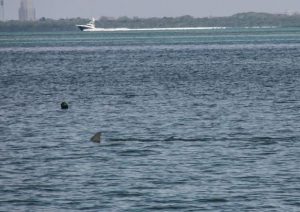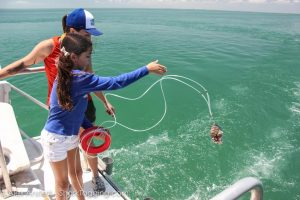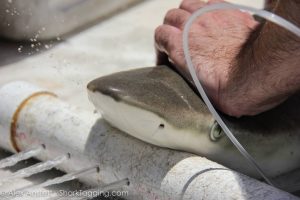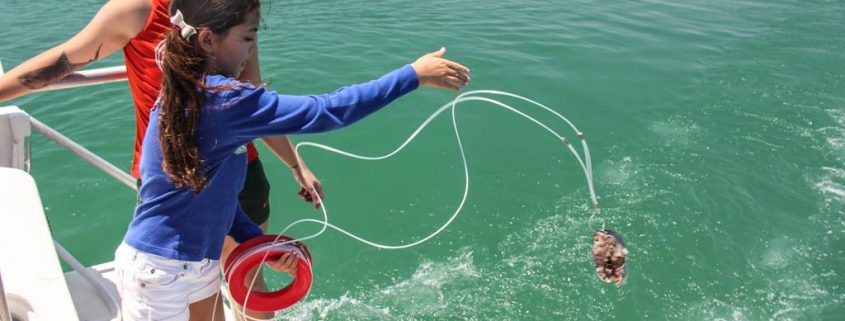Shark Tagging with Palmer Trinity Middle School
By Grace Roskar, SRC intern
The morning of Friday, April 29th was already proving that it would be a warm day as we set off for a day of shark tagging. Our guests, students from Palmer Trinity Middle School and Kelly and David, two citizen scientists from RSMAS, met the SRC team at Crandon Marina at 8:30 a.m. After trip leader David Shiffman gave a quick speech on what the day would be like for our student participants, we all gathered on the Diver’s Paradise boat to get underway. Captain Eric motored us out to the Safety Valve, a range of sand flats and tidal channels in Biscayne Bay that lies among the Stiltsville houses.
On our way out to the site, we noticed a dorsal fin cutting through the calm turquoise waters. A few seconds later, the large caudal fin appeared as well. SRC Masters student Robbie, who just published a paper on the subject, confirmed it was a hammerhead, presumably feeding on something in the shallows! We quickly started deploying gear in hopes to be able to catch and sample this hammerhead. We let the lines soak for one hour before retrieving them, and in the meantime, kept our glued to the the calm waters in case the hammerhead’s fins appeared again.

A hammerhead fin appears at the surface.
An hour later, Palmer Trinity students got their first opportunity to participate by helping the SRC team pull in the baited drumlines. The hammerhead was not on any of the first ten drumlines, but we did catch a beautiful healthy blacktip! Pat and David secured the blacktip onto the deck of the boat and readied it for the quick work-up process. The students helped test the shark’s nictitating membrane to measure the shark’s stress levels, took several body length measurements, took a sample of the dorsal fin, and inserted a tag underneath the shark’s dorsal fin. Several other morphological measurements and a blood sample were taken from the shark before it was safely released back into the clear blue waters of Biscayne Bay.

A Palmer Trinity student helps deploy a drumline.
On the next set of deployed drumlines, we pulled up a nurse shark that was on the smaller side. It was brought right onto the deck of the boat again, and after being safely secured, the next set of Palmer Trinity students helped with the work-up process again. This time, all the students were able to come down and touch the nurse shark, feeling its mosaic of dermal denticles. Because nurse sharks do not use ram ventilation to breathe, we were able to take a few minutes to let the students come down and feel the beautiful shark before needing to release it back into the water.

A water pump is placed in the shark’s mouth so that oxygenated seawater can flow over its gills during our quick work-up process. Here, it is evident where the blacknose shark gets its name!
The next shark pulled up was a blacknose shark, a rarer species for the SRC team! They are a smaller shark species, and stress easily, so we ensured to do a quick workup for the shark’s health and safety. Blacknose sharks are known to reside in murkier waters, which means they are not often seen and rarely photographed. SRC team member member Pat was able to get in the water with the shark after its release, to film it swimming away in great condition. The calm and clear waters allowed for the students to look on from the boat as the shark swam away peacefully.
Overall, we caught three different species of shark, one of which was fairly rare for the SRC team to encounter, and saw a hammerhead feeding in the shallows. It was a great day of tagging with our participants from Palmer Trinity and RSMAS, and we hope to have them out again with us soon!




Leave a Reply
Want to join the discussion?Feel free to contribute!